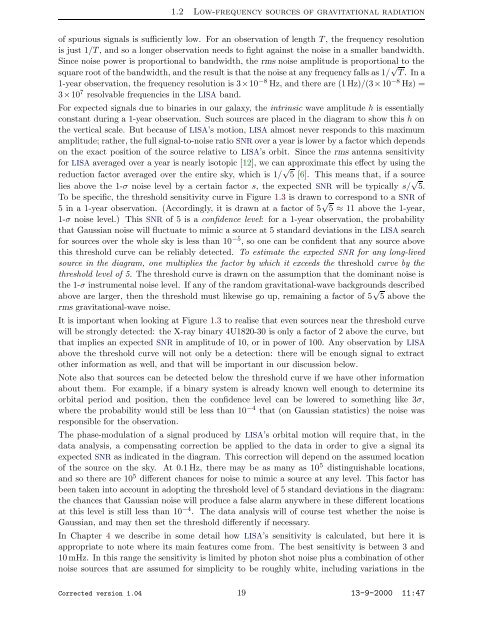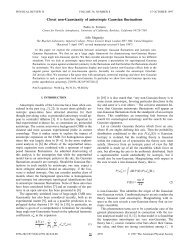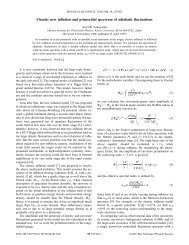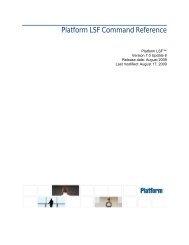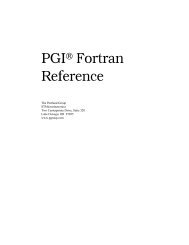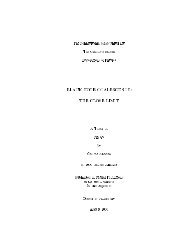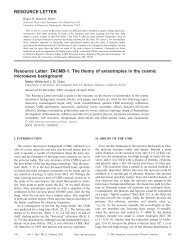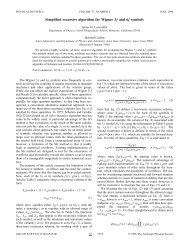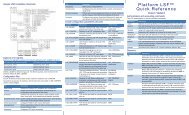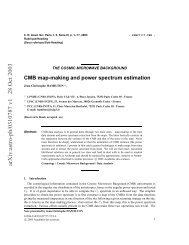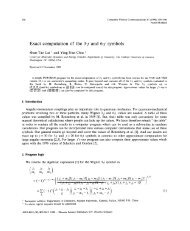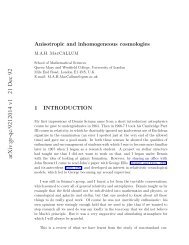LISALISA - iucaa
LISALISA - iucaa
LISALISA - iucaa
You also want an ePaper? Increase the reach of your titles
YUMPU automatically turns print PDFs into web optimized ePapers that Google loves.
1.2 Low-frequency sources of gravitational radiation<br />
of spurious signals is sufficiently low. For an observation of length T, the frequency resolution<br />
is just 1/T, and so a longer observation needs to fight against the noise in a smaller bandwidth.<br />
Since noise power is proportional to bandwidth, the rms noise amplitude is proportional to the<br />
square root of the bandwidth, and the result is that the noise at any frequency falls as 1/ √ T. In a<br />
1-year observation, the frequency resolution is 3×10 −8 Hz, and there are (1Hz)/(3×10 −8 Hz) =<br />
3×10 7 resolvable frequencies in the LISA band.<br />
For expected signals due to binaries in our galaxy, the intrinsic wave amplitude h is essentially<br />
constant during a 1-year observation. Such sources are placed in the diagram to show this h on<br />
the vertical scale. But because of LISA’s motion, LISA almost never responds to this maximum<br />
amplitude; rather, the full signal-to-noise ratio SNR over a year is lower by a factor which depends<br />
on the exact position of the source relative to LISA’s orbit. Since the rms antenna sensitivity<br />
for LISA averaged over a year is nearly isotopic [12], we can approximate this effect by using the<br />
reduction factor averaged over the entire sky, which is 1/ √ 5 [6]. This means that, if a source<br />
lies above the 1-σ noise level by a certain factor s, the expected SNR will be typically s/ √ 5.<br />
To be specific, the threshold sensitivity curve in Figure 1.3 is drawn to correspond to a SNR of<br />
5 in a 1-year observation. (Accordingly, it is drawn at a factor of 5 √ 5 ≈ 11 above the 1-year,<br />
1-σ noise level.) This SNR of 5 is a confidence level: for a 1-year observation, the probability<br />
that Gaussian noise will fluctuate to mimic a source at 5 standard deviations in the LISA search<br />
for sources over the whole sky is less than 10 −5 , so one can be confident that any source above<br />
this threshold curve can be reliably detected. To estimate the expected SNR for any long-lived<br />
source in the diagram, one multiplies the factor by which it exceeds the threshold curve by the<br />
threshold level of 5. The threshold curve is drawn on the assumption that the dominant noise is<br />
the 1-σ instrumental noise level. If any of the random gravitational-wave backgrounds described<br />
above are larger, then the threshold must likewise go up, remaining a factor of 5 √ 5 above the<br />
rms gravitational-wave noise.<br />
It is important when looking at Figure 1.3 to realise that even sources near the threshold curve<br />
will be strongly detected: the X-ray binary 4U1820-30 is only a factor of 2 above the curve, but<br />
that implies an expected SNR in amplitude of 10, or in power of 100. Any observation by LISA<br />
above the threshold curve will not only be a detection: there will be enough signal to extract<br />
other information as well, and that will be important in our discussion below.<br />
Note also that sources can be detected below the threshold curve if we have other information<br />
about them. For example, if a binary system is already known well enough to determine its<br />
orbital period and position, then the confidence level can be lowered to something like 3σ,<br />
where the probability would still be less than 10 −4 that (on Gaussian statistics) the noise was<br />
responsible for the observation.<br />
The phase-modulation of a signal produced by LISA’s orbital motion will require that, in the<br />
data analysis, a compensating correction be applied to the data in order to give a signal its<br />
expected SNR as indicated in the diagram. This correction will depend on the assumed location<br />
of the source on the sky. At 0.1 Hz, there may be as many as 10 5 distinguishable locations,<br />
and so there are 10 5 different chances for noise to mimic a source at any level. This factor has<br />
been taken into account in adopting the threshold level of 5 standard deviations in the diagram:<br />
the chances that Gaussian noise will produce a false alarm anywhere in these different locations<br />
at this level is still less than 10 −4 . The data analysis will of course test whether the noise is<br />
Gaussian, and may then set the threshold differently if necessary.<br />
In Chapter 4 we describe in some detail how LISA’s sensitivity is calculated, but here it is<br />
appropriate to note where its main features come from. The best sensitivity is between 3 and<br />
10 mHz. In this range the sensitivity is limited by photon shot noise plus a combination of other<br />
noise sources that are assumed for simplicity to be roughly white, including variations in the<br />
Corrected version 1.04 19 13-9-2000 11:47


